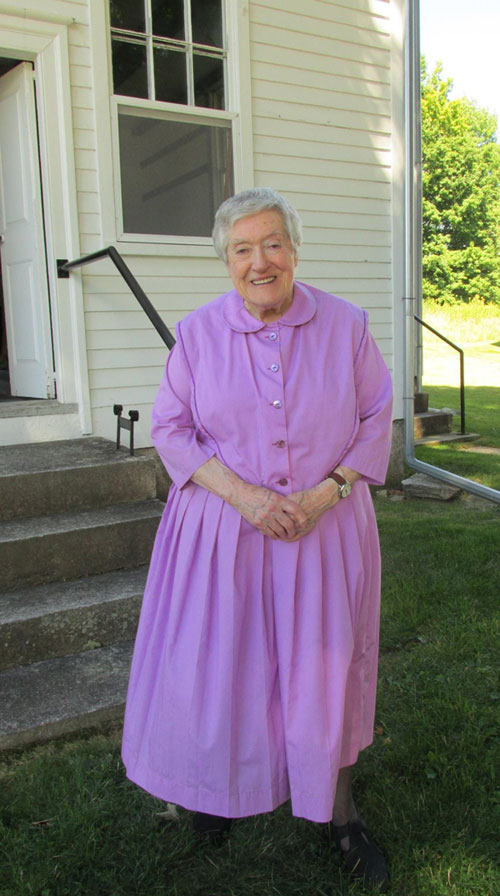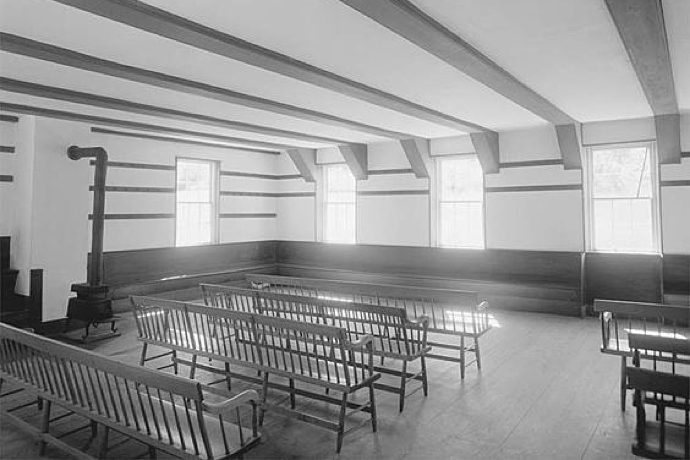On January 2, 2017, a small, distinctive, and beautiful world in our midst moved a bit closer to its own end. The first Monday of the New Year saw the passing of Sister Frances Carr, one of the last three remaining Shakers.
Sister Frances was a member of the Sabbathday Lake Shaker Village in New Gloucester, Maine who spent her life teaching and writing about her experiences as a member of the ever-dwindling, idiosyncratic Protestant denomination. Brother Arnold Hadd, one of those who survive her, reported that Sister Frances died “surrounded in love, tears and Shaker songs.”

Sister Frances Carr
A Shaker since the age of 10, Sister Frances converted to the faith with her mother after her father’s death. As the sect practices complete celibacy, no Shaker is born into the faith. With her death, a small, but significant, part of America’s religious ancestry moves closer to its extinction. To paraphrase John Donne, as the death of any person diminishes the individual, so of course does the death of Sister Frances diminishes our world a bit—and so much more so because she was a refugee of a counter-cultural tradition that held a bit of utopian promise against the machinery of state and industry.
Often confused with the far larger denomination of the Quakers (though itself a relatively small sect), the Shakers came from the same milieu of dissenting, radical religious traditions that emerged in 17th and 18th-century Britain. Ann Lee, the religion’s founder, was the daughter of a Manchester, England blacksmith. In 1774 she set out to the wilds of America with the promise of establishing a godly community in the New World. Mother Ann’s experiment became an important chapter in American utopianism, which included groups as varied as the Oneida Community, the Fourierists, the pilgrims at Ephrata and the social experiments of the 1960s. For Mother Ann, the New World was an opportunity to make the world new. As Mother Ann would reflect on her new home in upstate New York, “I saw a large tree, every leaf of which shone with such brightness as made it appear like a burning torch, representing the Church of Christ, which will yet be established in this land.”
Like so many other heterodox religious communities that proliferated in early America, Lee saw in the continent an opportunity for remaking society in a more just, egalitarian, and equitable way—including the radical equality of the sexes. Indeed the Shakers understood Christ’s return as being in a feminine form, and they understood their founder to be a messianic “manifestation of divine light.” For the Shakers, God’s gender was always understood as dualistic, as containing both the masculine and the feminine, and leadership was often matriarchal.
The cultural context that birthed the group was the same that led to the emergence of other exotic non-conformist sects in 17th-century England. Groups with strange names like the Ranters, the Seekers, and the Muggletonians have already disappeared. Others, like the Baptists and Methodists, are still around (if now less radical than they once were). Mother Ann’s role as the founder of the Shakers mirrored other women prophets like Jane Leade, Jane Wardley, and Anna Trapnell who proliferated in the years around the English civil wars and after. Their theological origins stem from the inventive dynamism of the English civil wars, but they branch into the equally inspired decades of the American First and Second Great Awakening, as such they are an important part of the most theologically creative periods in Christian history.
Groups like the Shakers represented a sort of “Second Reformation” in the 17th-century, one that took Luther’s injunction of a priesthood of all believers to its anarchic conclusion. Rejecting the conservatism of the magisterial Reformation, these non-conformist groups (so-called in England for refusing to conform to the official ecclesiastical settlement of the state) derived an even more revolutionary understanding of religious experience than the older Reformation’s call to reading scripture alone. Where Luther, Calvin, Zwingli and so on may have had sola Scriptura as an anti-traditionalist rallying cry, the dissenting churches of the English Revolution often claimed that it was human conscience, or the “Inner Light” as Quakers called it, that was the ultimate arbiter of God’s voice.
Officially known as “The United Society of Believers in Christ’s Second Appearing,” the Shakers have never had membership numbers on their side. At their height there were dozens of communities throughout New England, the Mid-Atlantic and the Midwest. Despite always being relatively small (as the rigors of their religious vocation, not to mention the imperative to celibacy was not widely attractive), the Shakers have had an outside influence on American culture. One can see it in the almost modernist minimalism of their furniture design that defined wood-working style of the 19th and 20th-century, to their hymnology that influenced Aaron Copeland’s magisterial orchestral suite Appalachian Spring.
But even more crucial than their rich cultural traditions is their witnessing to the possibility of legitimate counter-culture within the machinery of capitalist America. Like the Amish, the Shakers have represented an American counter-tradition that uses the vocabulary and experience of faith as a bulwark against systems of oppression. The Shakers were among the first conscientious objectors to compulsory military service in U.S. history.
That the Shakers, with their pacifism, their communal living, and perhaps most of all their celibacy, seem weird to us is precisely the point. As in the tradition of the radical Reformation they don’t just believe in separation of church and state, they see any collusion between religion and government as a profound rejection of Christ, as rendering all unto Caesar. For the Shakers, Constantine’s cross makes the shadow of a sword, it is only by setting themselves apart in a type of simple purity that the hypocrisies, violence, and oppression of the wider world can be demonstrated to the rest of us.
The Shakers, in their pious oddity and their strange holiness remain, however small, a crack in the wall that divides us in this increasingly insular, hierarchical, and oppressive era. They rejected the apparatus of state, economy, industry and military. Theirs was a pacifist army against Moloch’s minions. In offering us difference they enacted the possibility and promise of that difference.
Religions are intellectual ecosystems, and like biological ecosystems they are threatened by war, commerce, and the pernicious promises offered by oppressive normalacy. This century will most likely see the extinction of the Shakers, along with so many other groups like the Mandaeans, the Zoroastrians, the Yazidis and so on.
As I have written elsewhere, “Every religion is a world, every person is a world, and the destruction of either is a type of irredeemable apocalypse.” Individual religions are composed of their own unique metaphysics, ethics, cosmologies and theologies. The death of a religion is as the extinction of an entire world; the loss of a religion is the end of an entire universe. But we must remember that religions are not simply built out of metaphysics, ethics, cosmology and theology. They are built out of men and women.
Sister Frances is survived by Brother Arnold and Sister June Carpenter. And so we mourn.





